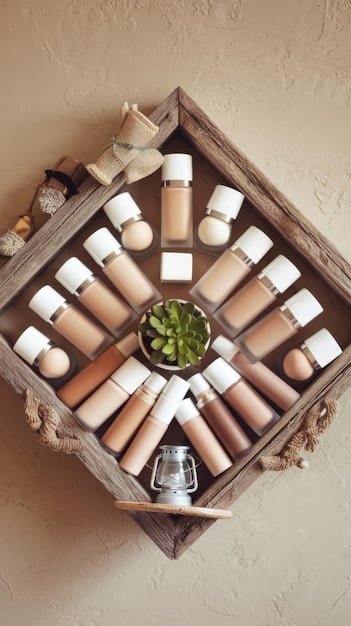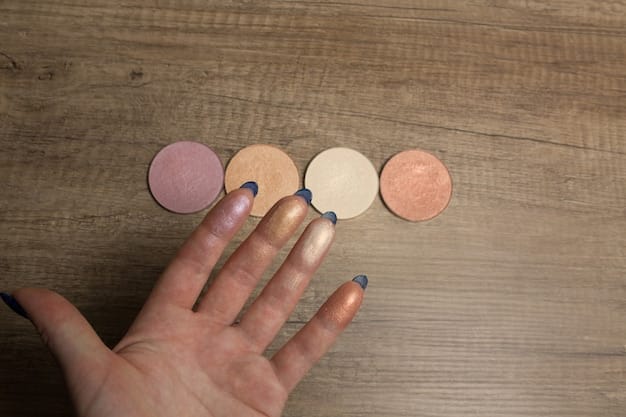The Ultimate Guide to Choosing the Right Foundation: Skin Type & Shade Matching

Choosing the right foundation involves understanding your skin type, identifying your undertones, and selecting a product that matches your skin’s needs for a flawless, natural-looking finish. This guide provides tips for achieving perfect shade matching.
Finding the perfect foundation can feel like searching for a needle in a haystack. With so many formulas, finishes, and shades available, how do you choose the right one? This The Ultimate Guide to Choosing the Right Foundation for Your Skin Type (with Shade Matching Tips) will break down everything you need to know to find your ideal match, ensuring a flawless and natural-looking complexion.
Understanding Your Skin Type
Before diving into the world of foundations, it’s crucial to understand your skin type. This knowledge will guide you in selecting a formula that caters to your skin’s specific needs, ensuring a comfortable and long-lasting wear.
Identifying Oily Skin
Oily skin is characterized by excess sebum production, often leading to a shiny appearance and enlarged pores. Individuals with oily skin may also experience frequent breakouts.
Recognizing Dry Skin
Dry skin lacks sufficient moisture, resulting in a tight, flaky, or even itchy complexion. Dry skin may also be more prone to fine lines and wrinkles.
Determining whether your skin is oily, dry, combination, sensitive, or neutral is the first step. Here’s a quick guide:
- Oily: Skin appears shiny and greasy, especially in the T-zone (forehead, nose, and chin).
- Dry: Skin feels tight, rough, and may flake or itch.
- Combination: Oily in the T-zone but dry on the cheeks.
- Sensitive: Skin is easily irritated, red, or prone to allergic reactions.
Understanding your skin type is paramount in choosing the right foundation, as it dictates the formula and ingredients that will work best for you.
Choosing the Right Foundation Formula
Once you’ve identified your skin type, you can start exploring the various foundation formulas available. Each formula offers unique benefits and is designed to cater to different skin types and concerns.
Liquid Foundations
Liquid foundations are versatile and come in a variety of finishes, from dewy to matte. They are suitable for most skin types, but it’s essential to choose a formula that aligns with your specific needs.
Powder Foundations
Powder foundations are ideal for oily skin, as they help absorb excess oil and provide a matte finish. They can also be used to set liquid foundations for extended wear.

Selecting the right formula is crucial for achieving a flawless finish. Consider these options based on your skin type:
- Oily Skin: Opt for oil-free, matte liquid or powder foundations. These formulas help control shine and prevent breakouts.
- Dry Skin: Choose hydrating liquid or cream foundations. Look for ingredients like hyaluronic acid and glycerin to provide moisture.
- Combination Skin: A lightweight liquid or powder foundation works well. You may need to use different formulas in different areas of your face.
Selecting the right foundation formula will increase the likelihood of it working for your skin type and skin concern.
Understanding Undertones for Perfect Shade Matching
Undertones are the subtle hues beneath your skin’s surface that influence how a foundation shade appears. Identifying your undertones is essential for achieving a seamless and natural-looking match.
Identifying Warm Undertones
Warm undertones have a golden, yellow, or peachy hue. Individuals with warm undertones often look best in warm-toned clothing and jewelry.
Recognizing Cool Undertones
Cool undertones have a pink, red, or blueish hue. Those with cool undertones typically look best in cool-toned colors.
Determining your skin’s undertone is crucial for a seamless match. Here are a few methods:
- The Vein Test: Look at the veins on your wrist. Blue or purple veins suggest cool undertones, while green veins indicate warm undertones. If you can’t tell, you likely have neutral undertones.
- The Jewelry Test: Which looks better against your skin, gold or silver jewelry? Gold typically complements warm undertones, while silver complements cool undertones.
- The White vs. Off-White Test: Hold a piece of pure white fabric next to your face, then try an off-white or cream color. If your skin looks brighter and more radiant against the off-white, you likely have warm undertones. If it looks better against the pure white, you probably have cool undertones.
Understanding your undertone ensures that your foundation blends seamlessly with your skin, creating a natural and even complexion.
Testing Foundation Shades
Once you’ve determined your skin type and undertones, it’s time to start testing foundation shades. This process involves applying small amounts of foundation to your skin and observing how it appears in different lighting conditions.
Swatching on Your Jawline
The jawline is the ideal area for testing foundation shades, as it transitions between your face and neck. Swatching here allows you to assess how well the foundation blends with both areas.
Observing in Natural Light
Natural light provides the most accurate representation of how a foundation shade will look on your skin. Avoid testing shades under artificial lighting, as it can distort the color.

Testing foundation shades is essential for finding the perfect match. Here’s how to do it:
- Swatch on Your Jawline: Apply a small amount of foundation to your jawline, blending it slightly. This allows you to see how well it matches both your face and neck.
- Check in Natural Light: The most accurate way to assess a foundation shade is in natural light. Check how the foundation looks in sunlight to ensure it blends seamlessly with your skin.
- Wait Before Deciding: Allow the foundation to sit on your skin for a few minutes. Some formulas oxidize, meaning they change color slightly after application.
Testing shades in different lighting conditions can ensure it matches your skin perfectly.
Application Techniques for a Flawless Finish
The way you apply your foundation can significantly impact its appearance. Using the right tools and techniques can help you achieve a flawless, natural-looking finish.
Using a Foundation Brush
Foundation brushes provide even coverage and allow you to easily blend the product into your skin.
Applying with a Sponge
Sponges create a more natural, airbrushed finish. They are particularly useful for blending foundation into hard-to-reach areas.
Different application methods yield different results. Experiment to find what works best for you:
- Foundation Brush: Provides buildable coverage and a smooth finish. Use a stippling brush for a natural look or a flat brush for more coverage.
- Makeup Sponge: Creates a dewy, airbrushed finish. Dampen the sponge before use to prevent it from absorbing too much product.
- Fingers: Your fingers can warm up the product, making it easier to blend. This method is best for light to medium coverage.
Choosing an effective application method will allow for the best results for your look.
Setting Your Foundation for Longevity
Setting your foundation is crucial for ensuring that it lasts throughout the day. Using the right setting products can help prevent creasing, fading, and shine.
Using Setting Powder
Setting powder helps absorb excess oil and locks your foundation in place. It is available in loose and pressed forms.
Applying Setting Spray
Setting spray provides a final layer of protection, helping to meld your makeup together and prolong its wear.
Properly setting your foundation ensures it lasts all day and reduces shine. Here are a few tips:
- Setting Powder: Use a light dusting of translucent setting powder to lock your foundation in place. Focus on areas prone to shine, such as the T-zone.
- Setting Spray: A setting spray helps to meld your makeup together and prolong its wear. Choose a matte finish for oily skin and a hydrating finish for dry skin.
- Blotting Papers: Carry blotting papers for touch-ups throughout the day. They absorb excess oil without disturbing your makeup.
Taking these steps will allow your makeup to stay fresh all day long.
| Key Point | Brief Description |
|---|---|
| ✨ Skin Type | Determine if your skin is oily, dry, combination, or sensitive. |
| 🎨 Undertone | Identify if your undertones are warm, cool, or neutral. |
| 🧪 Formula | Choose liquid, powder, cream, or stick based on skin type. |
| ☀️ Testing Shades | Test shades on jawline in natural light to find the perfect match. |
FAQ
▼
Observe your skin throughout the day. If it’s shiny all over, you likely have oily skin. If it feels tight and dry, you have dry skin. Combination skin is oily in the T-zone and dry elsewhere.
▼
Check the color of your veins. Blue or purple veins indicate cool undertones, while green veins suggest warm undertones. You can also see if gold or silver jewelry complements your skin better.
▼
Yes, mixing foundations is a great way to customize your shade. Use a lighter shade for brightening and a darker shade for contouring. Be sure to blend the formulas thoroughly.
▼
Replace your foundation every 6-12 months. Over time, the formula can break down and harbor bacteria. Check for changes in texture, smell, or color as signs of expiration.
▼
Use a damp makeup sponge for a sheer, natural finish. Apply thin layers and blend thoroughly. Focus on areas that need coverage, and avoid applying too much product to the entire face.
Conclusion
Finding the perfect foundation doesn’t have to be daunting. By understanding your skin type, identifying your undertones, and testing shades in natural light, you can achieve a flawless complexion that enhances your natural beauty. With the right techniques and products, you’ll be well on your way to foundation perfection.





